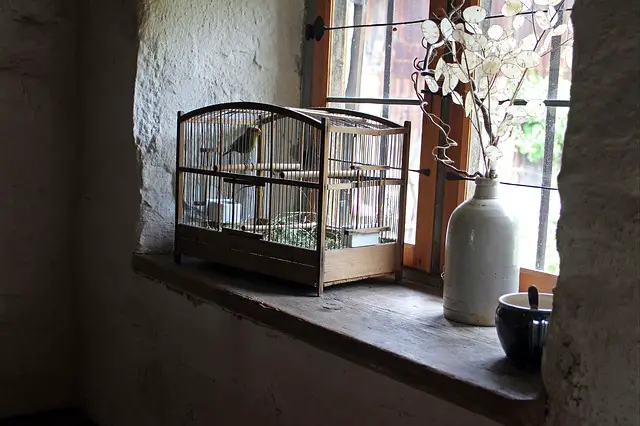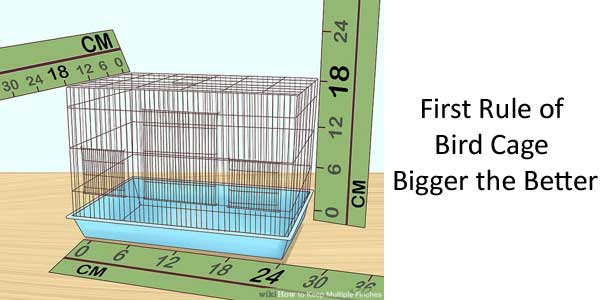Bird Cage | Things to Consider before buying
If you are a bird lover and planning to have a pet bird the first thing that you have to prioritise is the bird cage. Before thinking ‘how my bird cage would look’ or ‘What is the best bird cage’ think about ‘how comfortable your bird is in that cage’, ‘is it fulfilling all its demands, needs’; Think twice.
Actually the cage for your birds varies according to the species and also on where you want to place the cage. Cage which is perfect for cockatiels may be small for macaws.
If you want an indoor bird cage, pay extra attention to your pet’s mental health. place the cage in a location free from hazards.

Bird safe cage elements
Steel is mostly used for constructing cages with some form of anti corrosive coating. Cages designed for larger birds are typically powder coated and made of stainless steel as it tends to be strong and durable. Cages designed for smaller birds may employ less expensive techniques and materials such as plating, galvanising or plastic coating the steel wire.
Lead or zinc is harmful to your bird causing heavy metal toxicity. Avoid cages containing heavy metal. Shapes of the cages are also species-specific. Studies showed that a finch usually likes a wide cage where they have room to fly. Birds feel stressed in a rounded cage. Avoid those round shaped fancy bird cages. So choose a perfectly shaped cage to avoid stressing your pet.
Food and bath bowls
add four dishes for food and water as well as a bird bath. Use a separate bowl for fresh food e.g. veggies, sprouts and for pellets or seed mix. It is highly recommended to keep at least a few inches gap between the bottom of the case and the lining to prevent birds from accessing their waste.
Choose dishes that will hang from the side of the cage and are made for a bird to perch on. These types of dishes are easy to refill and more convenient than placing a bowl on the bottom of the cage. You can also use a water bottle in place of a water dish.
Birds can have many opportunities to bathe in the wild, so be sure to provide a bowl bathe in their cage. Choose a short, heavy, sturdy bowl, fill it with lukewarm water, and place it on the floor of the cage as a bird bath. You can also purchase a bird bath that hangs from the side of the cage to prevent moisture from gathering on the floor of the cage.
How to decorate pet bird cage
For decorating inside the case you should consider the bird species first. Different birds like different set ups; birds like parrots love to have toys in the cage whereas some small birds like to have small tree-like structures. Birds are highly intelligent and toys are important parts of their mental and physical aptitude. Toys encourage exercise, make them comfortable and provide good wear for the beak and nails. Toys give opportunity for holding, hanging, exploring and chewing. Birds need perches and spend a lot of their time enjoying them. place perches at different heights within the cage. use perches of different contours and textures, these will help them to fight with boredom.
Where should I put my bird cage
After constructing the cage you should look for the answer to the next question ‘where should I place the bird case’ or ‘what can be the ideal place for a bird cage’. Generally at least one side of the cage needs to be placed against a wall, as it provides them with a feeling of security. You can choose a corner of two walls that can be an ideal placement. Additionally, you shouldn’t keep your bird’s cage directly beside a window, as they may feel scared of the outside factors like dogs or storms. Some birds like to be part of the family, so you can put the case at a central position where they will get a lot of visitors and interactions. You should never put a bird cage at a place that vibrates like on the top of a refrigerator. Apparently this can make them feel insecure and lose their minds. Remember, sleep is vital to a bird’s well-being. Birds need 10-12 hours of sleep per night so make sure the cage is somewhere that’s relatively calm and dark at night. As long as a dark, quiet and somewhat separate area is provided for a bird to sleep in, most will be fine without being covered at night. If your bird is afraid of cage cover, do not hurry. slowly introduce cage cover to your bird. cage cover will help you to fight with hormonal issues and egg laying issues.
How often should you clean bird cage
The cage must be cleaned at least once weekly. must use a non-toxic disinfectant soap and hot water. After letting the disinfectants sit wet for 15 minutes on the surface a thorough brushing followed by a fresh water rinse is essential. Food and water dishes should be cleaned in the same way and should be washed and rinsed well daily. Don’t forget to wash your bird’s toys often with mild soap and warm water. Rinse them well enough with water and allow them to air dry completely before returning them to the cage.
Choose a room with linoleum, tile, or vinyl flooring, rather than carpet, if possible to facilitate the cleaning method. You can also place heavy plastic floor protectors (such as those used under desk chairs) underneath the birdcage. Tit will help to sweep up and clean your bird’s living space on a regular basis.
What do you put on the bottom of a bird cage
Change the lining every other day. Avoid using sand, wood shavings, or other materials in the bottom of the bird cage. Use newspapers at the bottom lining of the cage. Newspapers are cheap and can be thrown away every day.
Pet bird cage safety is an important thing to consider. Do not fool by the innocent look of your feathery baby. Always use a bird safe lock to your pet bird cage. Birds are highly intelligent and may escape from the cage and injure them.
